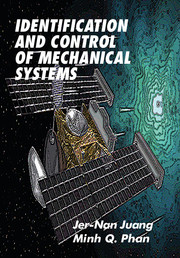Book contents
- Frontmatter
- Contents
- Preface
- 1 Ordinary Differential Equations
- 2 Elementary Matrix Algebra
- 3 Modeling Techniques
- 4 Finite-Element Method
- 5 Response of Dynamic Systems
- 6 Virtual Passive Controllers
- 7 State–Space Models
- 8 State-Feedback Control
- 9 Dynamic Feedback Controller
- 10 System Identification
- 11 Predictive Control
- Index
11 - Predictive Control
Published online by Cambridge University Press: 02 September 2009
- Frontmatter
- Contents
- Preface
- 1 Ordinary Differential Equations
- 2 Elementary Matrix Algebra
- 3 Modeling Techniques
- 4 Finite-Element Method
- 5 Response of Dynamic Systems
- 6 Virtual Passive Controllers
- 7 State–Space Models
- 8 State-Feedback Control
- 9 Dynamic Feedback Controller
- 10 System Identification
- 11 Predictive Control
- Index
Summary
Introduction
This chapter describes several computational algorithms to compute the predictive control law that has some feature of adaptive control. All algorithms make use of the multi-step-ahead output prediction as derived in Chap. 10 based on the finite-difference model. The generalized predictive control (GPC) algorithm (Ref. [1–4]) is based on system output predictions over a finite horizon known as the prediction horizon. In determining the future control inputs, it is assumed that control is applied only over a finite horizon known as the control horizon. The GPC is computed with the Toeplitz matrix formed from the step-response time history of the system in conjunction with a cost function with weighted input and output. The control input is obtained by minimization of the cost function. There are three design parameters involved: the control weight, the prediction horizon, and the control horizon. A proper combination of these parameters is required in order to guarantee stability of the predictive control law.
In contrast to the GPC approach, another approach is the deadbeat predictive control (DPC) (Ref. [5–9]). The DPC feedback law is supposed to bring the output response to rest after a few specific time steps. Similar to GPC, DPC has a control design parameter and an identification parameter related to the order of the system. The control design parameter, which is similar to the GPC control horizon, gives the number of time steps for the system to become deadbeat (rest). The DPC guarantees closed-loop stability for a controllable system.
Information
- Type
- Chapter
- Information
- Identification and Control of Mechanical Systems , pp. 295 - 332Publisher: Cambridge University PressPrint publication year: 2001
